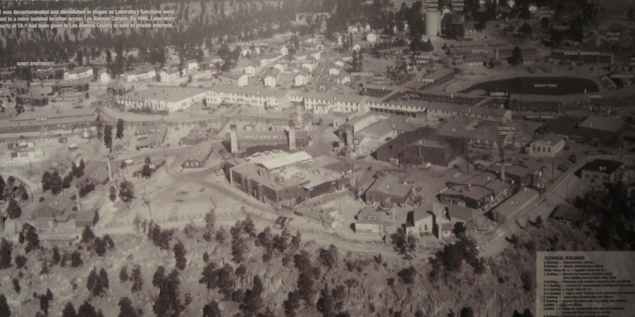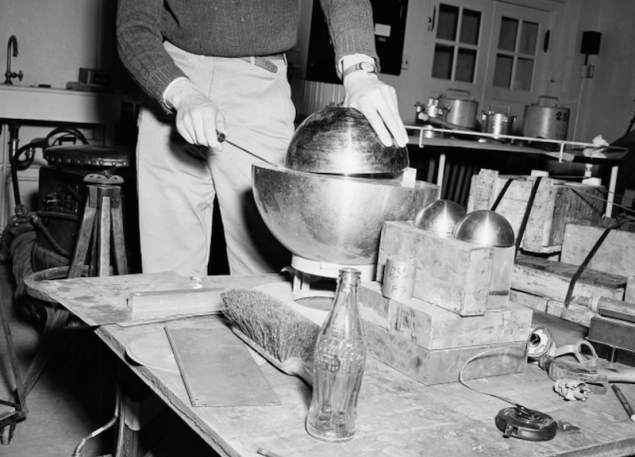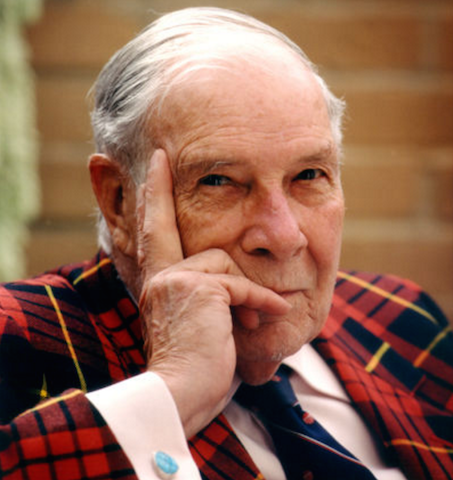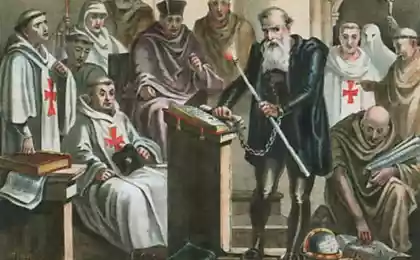1150
Richard Hamming - the genius of an idea
"If the problem is not solved, try to look at it from a different angle, turning it into a disadvantage advantage» .
Richard Wesley Hamming was born in Chicago, Illinois, February 11, 1915. His father - Richard Hamming Dutch origin, took part in the Boer War, he moved to America, worked for a cowboy, at the time of birth of her son has served as managing loans.
He spent his childhood in Chicago, where he graduated from high school and technical University. Richard Crane. Hamming originally wanted to study engineering, but it was the Great Depression - the global economic crisis and the means to study at another higher institution was not simple, and in the University. Richard Crane did not teach this discipline. Choosing the Faculty of Natural Sciences, Mathematics, in 1937 he received a bachelor's degree in the discipline. This turn of events has played a pivotal role in the life of the Hamming, because being an engineer ... "I would have been just a guy who repairs the sewage system, and my life is completely linked to the mind thrilling research work".

Hamming His training continued at the University of Nebraska. In 1939 he was awarded a master's degree. After that, he entered the University of Illinois at Urbana-Champaign. It wrote his doctoral thesis (on the problems of differential equations with boundary conditions) under the leadership of Waldemar Trjitzinsky theorem, who immigrated to America from Russia in 1920 and was a professor of mathematics from 1934 to 1969. Richard in 1942, received his Ph.D. in mathematics. While still a graduate student, Hamming "discovered" for himself Bull, I read his work "The study of the laws of thought."
In September 1942 Hamming married a classmate, Wanda Little, she later received a master's degree in English literature. With her he lived until his death, the children the couple had not. In 1944, a scientist became an assistant professor at the University of Louisville, Kentucky, United States (J.B. Speed Scientific School at the University of Louisville).

In 1945, Richard Hamming participated in the famous Manhattan research project, whose goal was to create an atomic bomb.
Manhattan Project At the beginning of 1943 across North America began to "disappear" people, whole families . Their names have been changed, no one knew where they go, it was impossible to directly use the railway / bus they run to any other station, and only there to buy train tickets. As a general rule, the final station was a stop unknown, Santa Fe or Albuquerque, after arriving at that, people took away the military machine and ... "no longer see them in the free world without a military escort."
Los Alamos did not exist. He was not on the map, he did not have e-mail addresses, the residents simply do not exist. Even a phone call is not allowed.
June 18, 1942, Colonel James Marshall (James Marshall) was ordered to create an organization that would have gathered the efforts of scientists and engineers to work on the creation of nuclear weapons. The project received the code name «The Manhattan Project». Simply said, this project is a program of research and development of the atomic bomb. Led by the United States and other countries (UK, Canada) also participated in the project. Project Manager was appointed Colonel Leslie Richard Groves. Manhattan Engineering District (MED) was established for the construction of a complex for the program.
The work was done in several ways: a study of isotopes of uranium, plutonium research, the creation of an optimal body for bombs. plutonium "Thing" (the Gadget), which was blown up in the first nuclear test, a uranium "The Kid" (a bomb in the form of a cannonball, stuffed uranium-235) dropped on Hiroshima and a plutonium «Fat man» (more than - three atomic bombs were created complex in structure bomb that blew up a sphere or a core of plutonium), dropped on Nagasaki. Events at Pearl Harbor accelerated test of a new weapon.

Allied Forces three plutonium charge was made for $ 500 million each. The first charge was used in the experiment "Trinity" July 16, 1945, which is considered the beginning of the atomic age. The second charge was exploded over Nagasaki, but the third charge, which is scheduled to lose to Japan, was taken to Los Alamos for further research, where he "killed" the scientists themselves and is now known as the "demon core".

Los Alamos 1946
Scientists at Los Alamos were brave men. To determine the critical mass of plutonium cores, which would be used for the experiment "Trinity" and the Fat Man bomb explosion, scientists from Los Alamos Louis Slotin procedure was developed, which received wonderful name of "tugging the dragon by the tail." For this "technique" Slotin lowered beryllium hemisphere on plutonium charge ... "beryllium - neutron reflector, so if you are close enough to the nucleus, the neutrons bounce back to plutonium, causing a supercritical state." Slotin almost completely covered the charge of beryllium hemisphere and the only thing that kept her completely cover it, it was the sting of a flat screwdriver. It turns out that the scientist held a screwdriver with a thin blade and it conducted an experiment, and that this tool! prevented a set of critical mass of plutonium and killing everyone in the room.

Sometimes screwdriver slipped and the scientist who held it, immediately "... roasted deadly neutrons." What happened as a result ... with Slotin screwdriver slipped out and charge plutonium scored supercritical mass, then let out a massive burst of neutron radiation. Slotin managed to turn the beryllium reflector, this stopping a chain reaction, but died of exposure after 9 days. And such a horrible incident, alas, was not the only one.

inside the lab
The developers of the atomic bomb yet realized the enormity of the invented weapons that could destroy all life. Interestingly, many members of the project participated in many peace organizations, at the same time advocated for universal disarmament and peace.
During World War II, Hamming left Louisville (in April 1945) to work on the Manhattan Project in the laboratory at Los Alamos, was in the unit to Hans Beta (Hans Bethe's), a division engaged in programming IBM computers that were used for the calculations carried out by physicists project. His wife Wanda soon joined him, and also worked at Los Alamos. Hamming recalled:
"Shortly before the first test, a physicist asked me to check out some arithmetic calculations, which he did, and I agreed. To my question about what kind of calculations, he said: "This is the probability of whether the bomb could" ignite "the whole atmosphere" Hearing the answer, I decided to check the calculations on their own the next day, when he came for the answer, I am.! I tried to explain to him that. "by the arithmetic - that's right, but I do not know many of the physical formula, which can make precise calculations" to which he replied that it was none of my business, and the only thing that was required of me, just check out . correct mathematical calculations One thought never left me, "What did you do, dear Hamming, you were involved in risky business, which threatens all life in the universe, while they themselves do not understand about half of what's going on!" I walked up and down the corridor, my friend came and asked what I was so excited I told him about the situation, his response was:.. "Nothing, Hamming, no one will ever blame you»
. Despite the short period of work in Los Alamos on the project, it is here that Richard Hamming closely acquainted with computer methods of computational mathematics, which dramatically influenced his entire career and life.
In 1946 Hamming began working with Bell Labs, he was adopted by a group of applied mathematicians. Here he worked for almost 30 years, invented and developed many numerical methods for solving scientific and engineering math problems. For a trip to New Jersey Hamming bought The old car from Klaus Fuchs, who later was revealed and declared a FBI spy. Hamming also summoned for questioning to testify.

Hamming at Bell Labs has long worked with Claude Shannon. "We have first-class troublemakers," - recalled Hamming later - "we unconventionally solved many things to give valuable results. This guide has been prepared to tolerate us, occupying the position of non-interference. »
It was at Bell Labs, Richard Hamming, working at Bell counting machine Model V, formulated later called Hamming code, the idea, dedicated codes for error correction and published it in 1950 in his only research article. The article described the block code design that corrects single errors when sending messages. Counting electromechanical machine Bell Model V worked in relay units, settlement rate was low, data is entered using punch cards, and in the process of reading errors frequently occur.
One Friday (1947), before going home for the weekend, Hamming set the machine to perform a long, complex series of calculations, but returned on Monday, found that at an initial stage there is an error, and this has led to the fact that the machine automatically came out of the program. All this irritated scientist, because had to work on weekends, often restart the program. It was necessary to build an effective error correction algorithms than Hamming and engaged. "If the computer can tell when an error occurs, there must be a way to" force "him to say exactly where it happened, and fix it»
. Created by Richard Hamming codes - self-checking, it allows you to automatically detect errors in data transmission. About own codes in this resource was not written enough, I repeat:
"Hamming code consists of two parts. The first part encodes the original message by inserting it in certain places control bits (calculated in a special way). The second part receives an incoming message, and recalculates the check bits (on the same algorithm as that of the first part). If all the newly computed check bits coincide with received, the message is received without error. Otherwise, an error message, and if possible error is corrected. "
Hamming code. An example of the algorithm
During the 1950s he was involved in the programming of one of the earliest computers, the IBM 650, together with Ruth A. Weiss (Ruth A. Weiss) L2 developed programming language, one of the earliest computer languages, in 1956, the language was widely used at Bell Labs as well as other users, he was known as Bell 2. In 1957, the language was replaced in Fortran, after IBM '650 has been replaced by the IBM 704.
In 1976, a scientist changed the place of residence and moved to the city of Monterey, California, where he led research in computer science at the Higher Naval School. Here he engaged in teaching, which still seriously interested in 1960, wrote a book on probability theory and combinatorics. Altogether, they have been written 9 books, some of which have been published many times and in many languages, including 3 - in the Soviet Union, and about 75 articles. Hamming has lectured as a visiting professor at Stanford University, City College of New York, the University of California at Irvine, the University of Princeton.
Hamming's work was marked by many awards, he was the recipient of many awards. In the field of artificial intelligence named after him artificial neural network Hamming used to classify images. In many ways (evolutionary modeling) used the concept of the Hamming distance (the most important concepts of coding theory). In his honor, even a special medal was established, which is awarded to scientists who have made significant contributions to the theory of information.

In 1968 he became an honorary member of the Institute of Electrical and Electronics Engineers (IEEE), he was awarded the Association for Computing Machinery Turing.
In 1979 him Prize Emmanuel Piora for exceptional contribution to the development of Information Sciences and Systems has been awarded.
In 1980, Richard Hamming was elected to the National Academy of Engineering Sciences.
In 1981, he won the Harold Pender from the University of Pennsylvania.
In 1988, the IEEE Medal of Honor.
In 1996 in Munich to work on codes, correcting errors, Hamming was awarded the prestigious Edward Reima in the amount of $ 130 000.

January 7, 1998, at the age of 82 years, stopped beating heart of the scholar Richard Hamming, suffered a heart attack.
Richard Hamming was the first to propose a constructive method of constructing codes with redundancy and a simple decoding. His work has predetermined the direction of the majority of works in this area, followed later. His article in 1950 has become a catalyst in speeding up the development of coding theory.
Source: geektimes.ru/company/ua-hosting/blog/275234/

Richard Wesley Hamming was born in Chicago, Illinois, February 11, 1915. His father - Richard Hamming Dutch origin, took part in the Boer War, he moved to America, worked for a cowboy, at the time of birth of her son has served as managing loans.
He spent his childhood in Chicago, where he graduated from high school and technical University. Richard Crane. Hamming originally wanted to study engineering, but it was the Great Depression - the global economic crisis and the means to study at another higher institution was not simple, and in the University. Richard Crane did not teach this discipline. Choosing the Faculty of Natural Sciences, Mathematics, in 1937 he received a bachelor's degree in the discipline. This turn of events has played a pivotal role in the life of the Hamming, because being an engineer ... "I would have been just a guy who repairs the sewage system, and my life is completely linked to the mind thrilling research work".

Hamming His training continued at the University of Nebraska. In 1939 he was awarded a master's degree. After that, he entered the University of Illinois at Urbana-Champaign. It wrote his doctoral thesis (on the problems of differential equations with boundary conditions) under the leadership of Waldemar Trjitzinsky theorem, who immigrated to America from Russia in 1920 and was a professor of mathematics from 1934 to 1969. Richard in 1942, received his Ph.D. in mathematics. While still a graduate student, Hamming "discovered" for himself Bull, I read his work "The study of the laws of thought."
In September 1942 Hamming married a classmate, Wanda Little, she later received a master's degree in English literature. With her he lived until his death, the children the couple had not. In 1944, a scientist became an assistant professor at the University of Louisville, Kentucky, United States (J.B. Speed Scientific School at the University of Louisville).

In 1945, Richard Hamming participated in the famous Manhattan research project, whose goal was to create an atomic bomb.
Manhattan Project At the beginning of 1943 across North America began to "disappear" people, whole families . Their names have been changed, no one knew where they go, it was impossible to directly use the railway / bus they run to any other station, and only there to buy train tickets. As a general rule, the final station was a stop unknown, Santa Fe or Albuquerque, after arriving at that, people took away the military machine and ... "no longer see them in the free world without a military escort."
Los Alamos did not exist. He was not on the map, he did not have e-mail addresses, the residents simply do not exist. Even a phone call is not allowed.
June 18, 1942, Colonel James Marshall (James Marshall) was ordered to create an organization that would have gathered the efforts of scientists and engineers to work on the creation of nuclear weapons. The project received the code name «The Manhattan Project». Simply said, this project is a program of research and development of the atomic bomb. Led by the United States and other countries (UK, Canada) also participated in the project. Project Manager was appointed Colonel Leslie Richard Groves. Manhattan Engineering District (MED) was established for the construction of a complex for the program.
The work was done in several ways: a study of isotopes of uranium, plutonium research, the creation of an optimal body for bombs. plutonium "Thing" (the Gadget), which was blown up in the first nuclear test, a uranium "The Kid" (a bomb in the form of a cannonball, stuffed uranium-235) dropped on Hiroshima and a plutonium «Fat man» (more than - three atomic bombs were created complex in structure bomb that blew up a sphere or a core of plutonium), dropped on Nagasaki. Events at Pearl Harbor accelerated test of a new weapon.

Allied Forces three plutonium charge was made for $ 500 million each. The first charge was used in the experiment "Trinity" July 16, 1945, which is considered the beginning of the atomic age. The second charge was exploded over Nagasaki, but the third charge, which is scheduled to lose to Japan, was taken to Los Alamos for further research, where he "killed" the scientists themselves and is now known as the "demon core".

Los Alamos 1946
Scientists at Los Alamos were brave men. To determine the critical mass of plutonium cores, which would be used for the experiment "Trinity" and the Fat Man bomb explosion, scientists from Los Alamos Louis Slotin procedure was developed, which received wonderful name of "tugging the dragon by the tail." For this "technique" Slotin lowered beryllium hemisphere on plutonium charge ... "beryllium - neutron reflector, so if you are close enough to the nucleus, the neutrons bounce back to plutonium, causing a supercritical state." Slotin almost completely covered the charge of beryllium hemisphere and the only thing that kept her completely cover it, it was the sting of a flat screwdriver. It turns out that the scientist held a screwdriver with a thin blade and it conducted an experiment, and that this tool! prevented a set of critical mass of plutonium and killing everyone in the room.

Sometimes screwdriver slipped and the scientist who held it, immediately "... roasted deadly neutrons." What happened as a result ... with Slotin screwdriver slipped out and charge plutonium scored supercritical mass, then let out a massive burst of neutron radiation. Slotin managed to turn the beryllium reflector, this stopping a chain reaction, but died of exposure after 9 days. And such a horrible incident, alas, was not the only one.

inside the lab
The developers of the atomic bomb yet realized the enormity of the invented weapons that could destroy all life. Interestingly, many members of the project participated in many peace organizations, at the same time advocated for universal disarmament and peace.
During World War II, Hamming left Louisville (in April 1945) to work on the Manhattan Project in the laboratory at Los Alamos, was in the unit to Hans Beta (Hans Bethe's), a division engaged in programming IBM computers that were used for the calculations carried out by physicists project. His wife Wanda soon joined him, and also worked at Los Alamos. Hamming recalled:
"Shortly before the first test, a physicist asked me to check out some arithmetic calculations, which he did, and I agreed. To my question about what kind of calculations, he said: "This is the probability of whether the bomb could" ignite "the whole atmosphere" Hearing the answer, I decided to check the calculations on their own the next day, when he came for the answer, I am.! I tried to explain to him that. "by the arithmetic - that's right, but I do not know many of the physical formula, which can make precise calculations" to which he replied that it was none of my business, and the only thing that was required of me, just check out . correct mathematical calculations One thought never left me, "What did you do, dear Hamming, you were involved in risky business, which threatens all life in the universe, while they themselves do not understand about half of what's going on!" I walked up and down the corridor, my friend came and asked what I was so excited I told him about the situation, his response was:.. "Nothing, Hamming, no one will ever blame you»
. Despite the short period of work in Los Alamos on the project, it is here that Richard Hamming closely acquainted with computer methods of computational mathematics, which dramatically influenced his entire career and life.
In 1946 Hamming began working with Bell Labs, he was adopted by a group of applied mathematicians. Here he worked for almost 30 years, invented and developed many numerical methods for solving scientific and engineering math problems. For a trip to New Jersey Hamming bought The old car from Klaus Fuchs, who later was revealed and declared a FBI spy. Hamming also summoned for questioning to testify.

Hamming at Bell Labs has long worked with Claude Shannon. "We have first-class troublemakers," - recalled Hamming later - "we unconventionally solved many things to give valuable results. This guide has been prepared to tolerate us, occupying the position of non-interference. »
It was at Bell Labs, Richard Hamming, working at Bell counting machine Model V, formulated later called Hamming code, the idea, dedicated codes for error correction and published it in 1950 in his only research article. The article described the block code design that corrects single errors when sending messages. Counting electromechanical machine Bell Model V worked in relay units, settlement rate was low, data is entered using punch cards, and in the process of reading errors frequently occur.
One Friday (1947), before going home for the weekend, Hamming set the machine to perform a long, complex series of calculations, but returned on Monday, found that at an initial stage there is an error, and this has led to the fact that the machine automatically came out of the program. All this irritated scientist, because had to work on weekends, often restart the program. It was necessary to build an effective error correction algorithms than Hamming and engaged. "If the computer can tell when an error occurs, there must be a way to" force "him to say exactly where it happened, and fix it»
. Created by Richard Hamming codes - self-checking, it allows you to automatically detect errors in data transmission. About own codes in this resource was not written enough, I repeat:
"Hamming code consists of two parts. The first part encodes the original message by inserting it in certain places control bits (calculated in a special way). The second part receives an incoming message, and recalculates the check bits (on the same algorithm as that of the first part). If all the newly computed check bits coincide with received, the message is received without error. Otherwise, an error message, and if possible error is corrected. "
Hamming code. An example of the algorithm
During the 1950s he was involved in the programming of one of the earliest computers, the IBM 650, together with Ruth A. Weiss (Ruth A. Weiss) L2 developed programming language, one of the earliest computer languages, in 1956, the language was widely used at Bell Labs as well as other users, he was known as Bell 2. In 1957, the language was replaced in Fortran, after IBM '650 has been replaced by the IBM 704.
In 1976, a scientist changed the place of residence and moved to the city of Monterey, California, where he led research in computer science at the Higher Naval School. Here he engaged in teaching, which still seriously interested in 1960, wrote a book on probability theory and combinatorics. Altogether, they have been written 9 books, some of which have been published many times and in many languages, including 3 - in the Soviet Union, and about 75 articles. Hamming has lectured as a visiting professor at Stanford University, City College of New York, the University of California at Irvine, the University of Princeton.
Hamming's work was marked by many awards, he was the recipient of many awards. In the field of artificial intelligence named after him artificial neural network Hamming used to classify images. In many ways (evolutionary modeling) used the concept of the Hamming distance (the most important concepts of coding theory). In his honor, even a special medal was established, which is awarded to scientists who have made significant contributions to the theory of information.

In 1968 he became an honorary member of the Institute of Electrical and Electronics Engineers (IEEE), he was awarded the Association for Computing Machinery Turing.
In 1979 him Prize Emmanuel Piora for exceptional contribution to the development of Information Sciences and Systems has been awarded.
In 1980, Richard Hamming was elected to the National Academy of Engineering Sciences.
In 1981, he won the Harold Pender from the University of Pennsylvania.
In 1988, the IEEE Medal of Honor.
In 1996 in Munich to work on codes, correcting errors, Hamming was awarded the prestigious Edward Reima in the amount of $ 130 000.

January 7, 1998, at the age of 82 years, stopped beating heart of the scholar Richard Hamming, suffered a heart attack.
Richard Hamming was the first to propose a constructive method of constructing codes with redundancy and a simple decoding. His work has predetermined the direction of the majority of works in this area, followed later. His article in 1950 has become a catalyst in speeding up the development of coding theory.
Source: geektimes.ru/company/ua-hosting/blog/275234/























